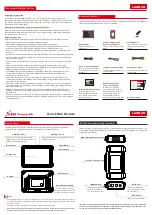
1
Introduction
Data Types
14
TSQ Quantum XLS and TSQ Quantum GC User Guide
Thermo Scientific
The mass spectrometer uses reference SRM scans to adjust the acquisition time window of
subsequent SRM scans. It uses the time difference between the expected and observed
retention times of reference SRM reactions to correct the retention times that it uses to make
procedural decisions. The mass spectrometer still records data with the true retention times.
You should specify two to four reference reactions spaced throughout the LC run. The mass
spectrometer uses the preceeding two retention time corrections to calculate a piecewise linear
retention time correction for the primary SRM scans that follow. As with primary SRM scans,
reference SRM scans may trigger secondary SRM scans.
The maximum number of primary plus reference SRM transitions is 3600.
Quantitation-Enhanced, Data-Dependent MS (QED MS)
Quantitation-enhanced, data-dependent MS
(QED MS) scan type provides simultaneous
quantitation (SRM) and structural confirmation (full-scan MS/MS product ion spectra). If
the intensity of an SRM reaction that you specify for a parent ion is above its trigger
threshold, the mass spectrometer performs a full-scan MS/MS product ion scan to confirm
the identity of the analyte.
AutoSIM
In the scan type known as AutoSIM, the mass spectrometer automatically selects the most
intense masses (
m/z
values) in a survey scan, builds a SIM scan list for them, and then acquires
and records ion current at only these selected masses. AutoSIM scans can be performed on any
full scan in any scan mode, but not on data-dependent scans.
Data Types
You can acquire and display mass spectral data (intensity versus mass-to-charge ratio) with the
TSQ Quantum XLS and TSQ Quantum GC mass spectrometers in one of two data types:
• Profile data type
• Centroid data type
Profile Data Type
In the profile data type, you can see the shape of the peaks in the mass spectrum. Each atomic
mass unit is divided into many sampling intervals. The intensity of the ion current is
determined at each of the sampling intervals. The profile data type displays the intensity at
each sampling interval with the intensities connected by a continuous line. In general, use the
profile scan data type when you tune and calibrate the mass spectrometer so that you can
easily see and measure mass resolution.
















































